Experimental Study on the Distribution of Wave-Induced Excess Pore Pressure in a Sandy Seabed around a Mat Foundation
Abstract
:1. Introduction
2. Experimental Formulation
2.1. Experimental Set-Up
2.2. Test Procedure and Experimental Conditions
- (1)
- Empty and clean the wave flume and the soil-box before the experiment;
- (2)
- Fix the measuring instruments at the predesigned site, including three wave height gauges, an ADCP, and nine PPTs;
- (3)
- The soil box was filled slowly with clean water to the required depth to reduce air entrainment. Then the sandy seabed was left over a period (12 h) to ensure being fully saturated;
- (4)
- Place the mat foundation on the specific position of the sandy seabed. Use a gradient to ensure that the instrument is placed horizontally;
- (5)
- Slowly pump water into the flume until the designed water depth (0.6 m) is reached;
- (6)
- Calibrate the parameters of the wave generator by comparing the input data of wave height with the observed value of the far-field wave gauge;
- (7)
- The experiment starts collecting the data record by switching on the wave generator;
- (8)
- Repeat steps 6–7 for the next test, and steps 4–7 if the model position needs to be changed.
3. Result and Discussions
3.1. Numerical Verification
3.1.1. Set Up of the Numerical Model
3.1.2. Comparison Between Numerical and Experimental Results
3.2. Effect of Mat Foundation
3.2.1. Wave Motion
3.2.2. Wave-Induced Pore Pressure
3.3. Plane Distribution of the Pore Pressure
3.4. Vertical Distribution of the Pore Pressure
3.5. Numerical Results of the Spatial Distribution of Pore Pressure
4. Conclusions
- (1)
- The good agreement between the experimental and the numerical results shows that the strong reliability of the experimental test. Moreover, the degree of saturation of soil is considered as 0.95 with the numerical simulation;
- (2)
- The comparison between the test with and without the mat foundation indicates that the wave motion was seldom affected by the mat foundation since the height of the mat is much lower than the water depth. The variation of the pore pressure in both tests suggests that the amplitude of excess pore pressure is affected by the existence of the mat foundation;
- (3)
- The affected region with increased pore pressure reaches a length of before the mat. The largest pore pressure occurs at before the mat, which is near twice the minimum value (at the center under the mat) in most tests;
- (4)
- Along with the seabed depth, there is a decreasing trend of excess pore pressure and a phase lag without residual pore pressure. The experimental and numerical results show that a significantly affected seabed region due to waves is within depth under the mat foundation;
- (5)
- The distribution of the pore pressure around the mat foundation varies with wave heights and wave periods, and the wave period has a stronger influence. The change of mat foundation orientation will alter the pore pressure amplitude under and around the mat; The existence of current expands the range of the affected region with higher pore pressure, and increases the maximum value by about 80%.
Author Contributions
Funding
Acknowledgments
Conflicts of Interest
References
- Zhao, H.; Jeng, D. 2D Model for Wave-Induced Pore Pressure Accumulation Around a Rubble Mound Breakwater over Sloping Seabed. In The Eleventh ISOPE Pacific/Asia Offshore Mechanics Symposium; ISOPE: Mountain View, CA, USA, 2014. [Google Scholar]
- Zhang, J.S.; Jeng, D.S.; Liu, P.L.F. Numerical study for waves propagating over a porous seabed around a submerged permeable breakwater: PORO-WSSI II model. Ocean Eng. 2011, 38, 954–966. [Google Scholar] [CrossRef]
- Liao, C.; Tong, D.; Chen, L. Pore Pressure Distribution and Momentary Liquefaction in Vicinity of Impermeable Slope-Type Breakwater Head. Appl. Ocean Res. 2019, 78, 290–306. [Google Scholar] [CrossRef]
- Lu, P.; Maclaren, D. Geotechnical challenge of offshore mudmat foundation stability: Combining analytical and finite element investigation of bearing capacity of sand overlying soft clay. Geomech. Energy Environ. 2016, 6, 58–69. [Google Scholar] [CrossRef]
- Semenov, K.K.; Lebedev, V.V.; Nudner, I.S.; Geidarov, N.A.; Ivanov, K.S. Impact of waves and currents on the soil near gravity-Type offshore platform foundation: Numerical and experimental studies. In Proceedings of the Twenty-Fifth International Ocean and Polar Engineering Conference, Kona, HI, USA, 21–26 June 2015. [Google Scholar]
- Li, Y.; Ong, M.C.; Tang, T. Numerical analysis of wave-Induced poro-Elastic seabed response around a hexagonal gravity-Based offshore foundation. Coast. Eng. 2018, 136, 81–95. [Google Scholar] [CrossRef]
- Tsai, C.P. Wave-Induced liquefaction potential in a porous seabed in front of a breakwater. Ocean Eng. 1995, 22, 1–18. [Google Scholar] [CrossRef]
- Higuera, P.; Lara, J.L.; Losada, I.J. Three-Dimensional interaction of waves and porous coastal structures using OpenFOAM®. Part I: Formulation and validation. Coast. Eng. 2014, 83, 243–258. [Google Scholar] [CrossRef]
- Jeng, D.S. Wave-Induced sea floor dynamics. Appl. Mech. Rev. 2003, 56, 407. [Google Scholar] [CrossRef]
- Zhang, J.S.; Zhang, Y.; Jeng, D.S.; Liu, P.L.F.; Zhang, C. Numerical simulation of wave–Current interaction using a RANS solver. Ocean Eng. 2014, 75, 157–164. [Google Scholar] [CrossRef]
- Biot, M.A. General Theory of Three-Dimensional Consolidation. J. Appl. Phys. 1941, 2, 155–164. [Google Scholar] [CrossRef]
- Mizutani, N.; Mostafa, A.M.; Iwata, K. Nonlinear regular wave, submerged breakwater and seabed dynamic interaction. Coast. Eng. 1998, 33, 177–202. [Google Scholar] [CrossRef]
- Jeng, D.S.; Ye, J.H.; Zhang, J.S.; Liu, P.L.F. An integrated model for the wave-induced seabed response around marine structures: Model verifications and applications. Coast. Eng. 2013, 72, 1–19. [Google Scholar] [CrossRef]
- Liu, B.; Jeng, D.S.; Ye, G.L.; Yang, B. Laboratory study for pore pressures in sandy deposit under wave loading. Ocean Eng. 2015, 106, 207–219. [Google Scholar] [CrossRef]
- Losada, M.A.; Losada, I.J.; Patterson, M.D. Harmonic generation past a submerged porous step. Coast. Eng. 1997, 31, 281–304. [Google Scholar] [CrossRef]
- Bierawski, L.G.; Maeno, S. An experimental study on the interaction between the reef breakwater the sandy bed and the wave field. In Proceedings of the 30TH IAHR Congress, Thessaloniki, Greece, 24–29 August 2003; pp. 377–384. [Google Scholar]
- Mizutani, N.; Mostafa, A.M. Nonlinear wave-induced seabed instability around coastal structures. Coast. Eng. J. 1998, 40, 131–160. [Google Scholar] [CrossRef]
- Qi, W.; Li, C.; Jeng, D.; Gao, F.; Liang, Z. Combined wave-Current induced excess pore-Pressure in a sandy seabed: Flume observations and comparisons with theoretical models. Coast. Eng. 2019, 147, 89–98. [Google Scholar] [CrossRef]
- Arena, F.; Filianoti, P. Small-Scale Field Experiment on a Submerged Breakwater for Absorbing Wave Energy. J. Waterw. Port Coast. Ocean Eng. 2007, 133, 161–167. [Google Scholar] [CrossRef]
- Czitrom, S.P.R.; Godoy, R.; Prado, E.; Olvera, A.; Stern, C. Hydrodynamics of an oscillating water column seawater pump. Part II: Tuning to monochromatic waves. Ocean Eng. 2000, 27, 1199–1219. [Google Scholar] [CrossRef]
- Ryu, D.; Lee, C.; Choi, K.; Koo, B.; Song, J.; Kim, M.; Lee, J. Lab-Scale impact test to investigate the pipe-Soil interaction and comparative study to evaluate structural responses. Int. J. Nav. Arch. Ocean 2015, 7, 720–738. [Google Scholar] [CrossRef]
- Boccotti, P.; Barbaro, G.; Mannino, L. A field experiment on the mechanics of irregular gravity waves. J. Fluid Mech. 1993, 252, 173–186. [Google Scholar] [CrossRef]
- Liao, C.; Tong, D.; Jeng, D.; Zhao, H. Numerical study for wave-Induced oscillatory pore pressures and liquefaction around impermeable slope breakwater heads. Ocean Eng. 2018, 157, 364–375. [Google Scholar] [CrossRef]
- Liao, C.; Chen, J.; Zhang, Y. Accumulation of pore water pressure in a homogeneous sandy seabed around a rocking mono-Pile subjected to wave loads. Ocean Eng. 2019, 173, 810–822. [Google Scholar] [CrossRef]
- Tong, D.; Liao, C.; Chen, J.; Zhang, Q. Numerical Simulation of a Sandy Seabed Response to Water Surface Waves Propagating on Current. J. Mar. Sci. Eng. 2018, 6, 88. [Google Scholar] [CrossRef]
- Hirt, C.W.; Nichols, B.D. Volume of fluid (VOF) method for the dynamics of free boundaries. J. Comput. Phys. 1981, 39, 201–225. [Google Scholar] [CrossRef]
- Ye, J.H.; Jeng, D.S. Response of Porous Seabed to Nature Loadings: Waves and Currents. J. Eng. Mech. 2012, 138, 601–613. [Google Scholar] [CrossRef]
- Zhou, C.; Li, G.; Dong, P.; Shi, J.; Xu, J. An experimental study of seabed responses around a marine pipeline under wave and current conditions. Ocean Eng. 2011, 38, 226–234. [Google Scholar] [CrossRef]
- Jeng, D.S.; Schacht, C.; Lemckert, C. Experimental study on ocean waves propagating over a submerged breakwater in front of a vertical seawall. Ocean Eng. 2005, 32, 2231–2240. [Google Scholar] [CrossRef]
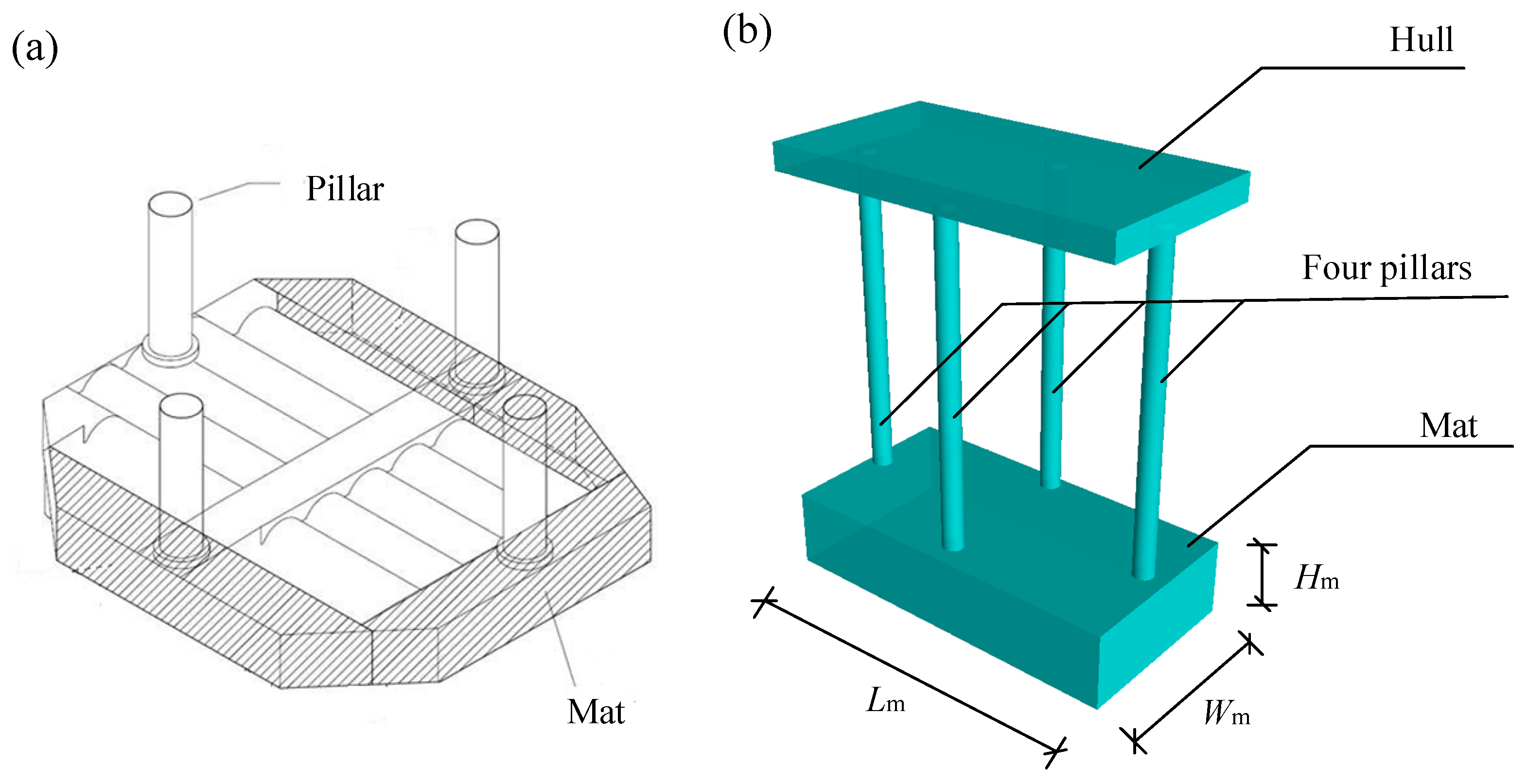
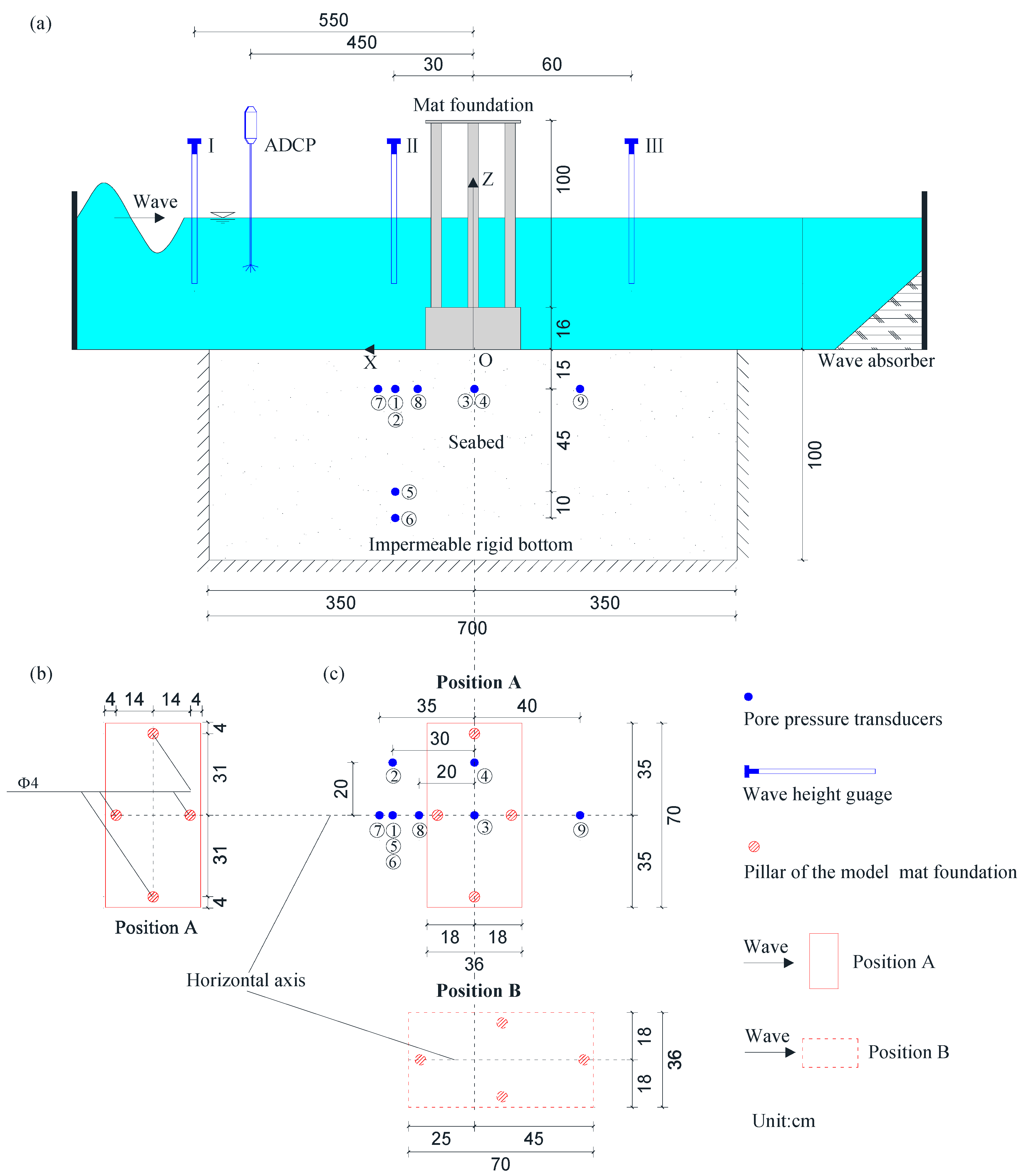



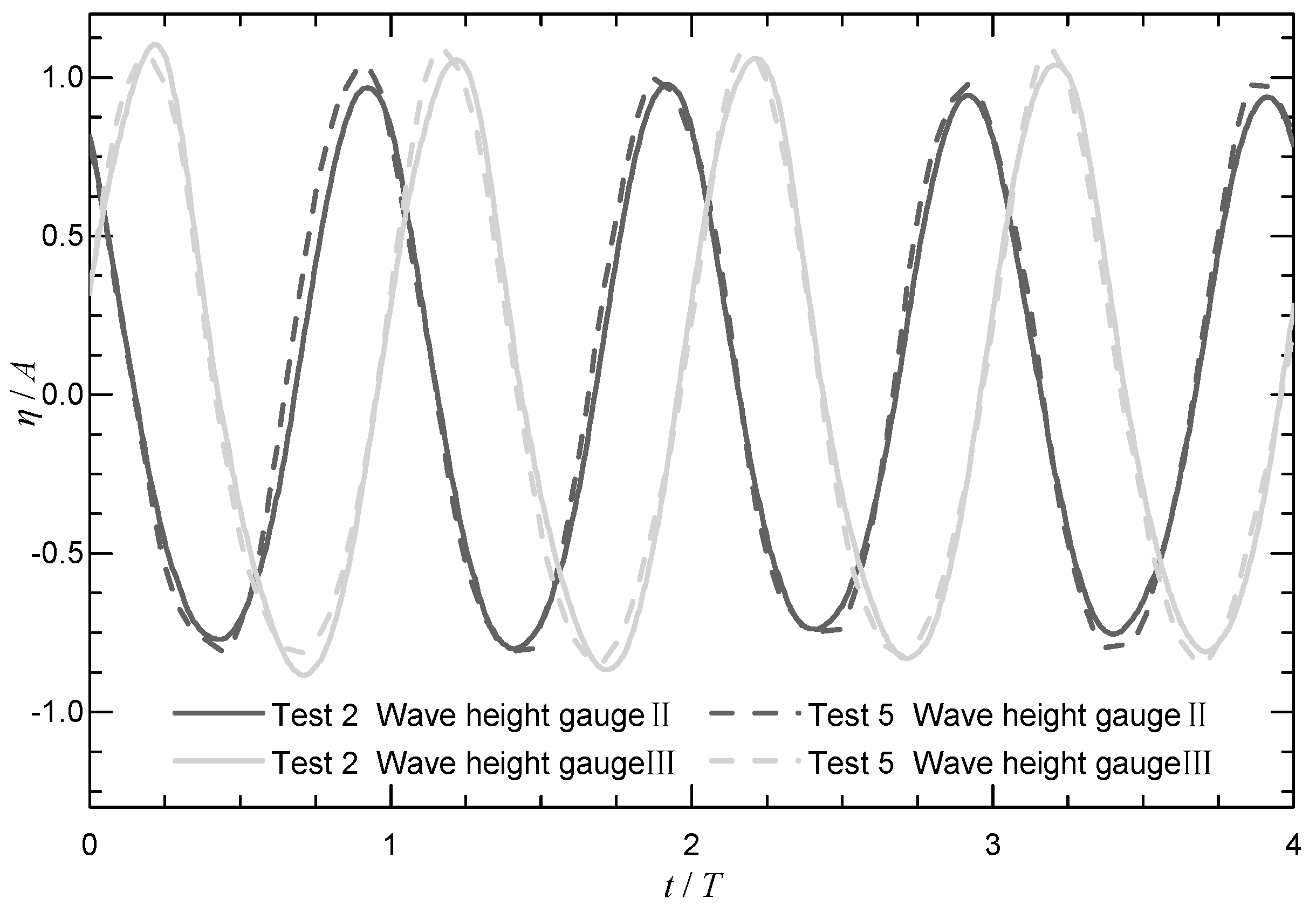
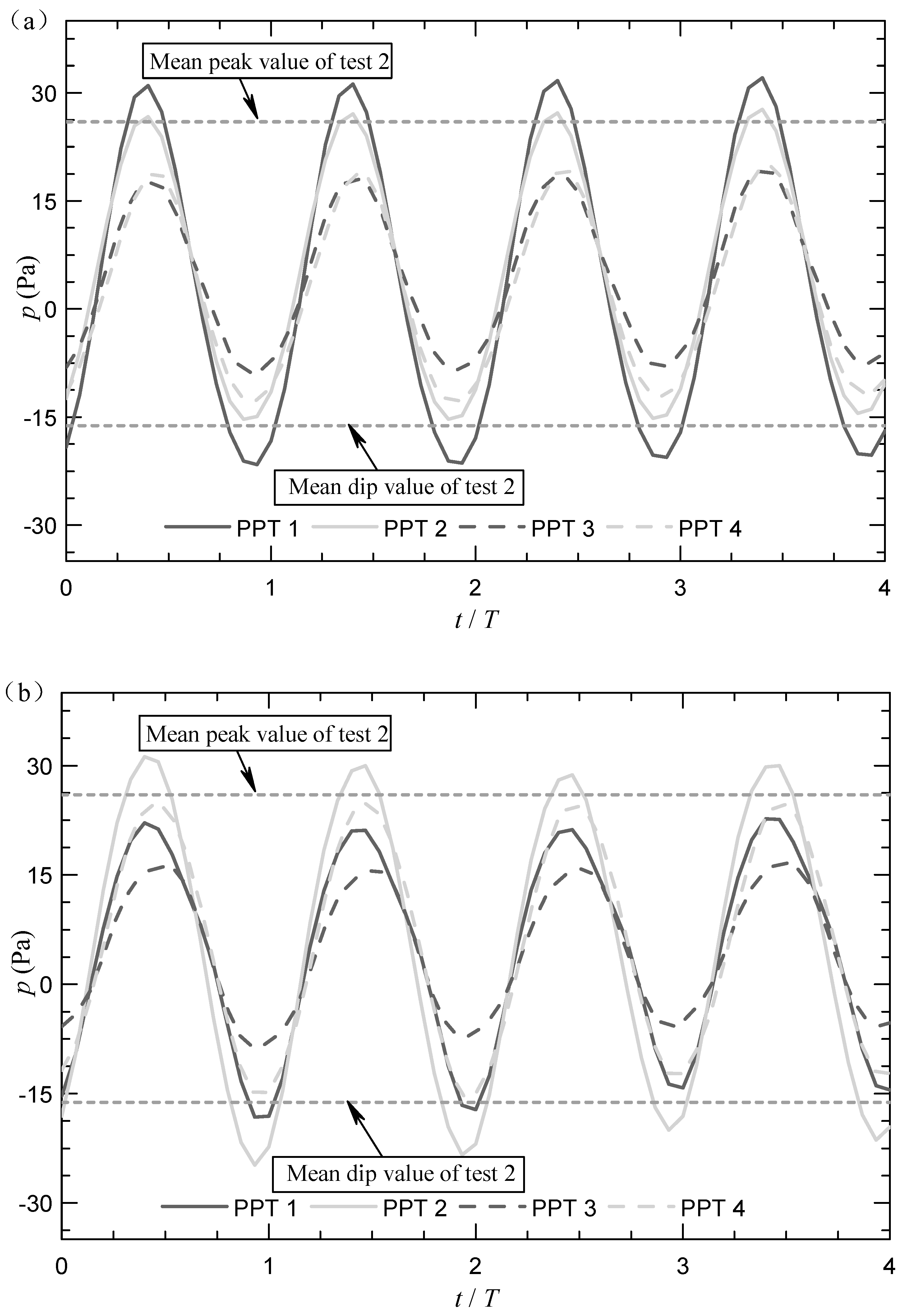

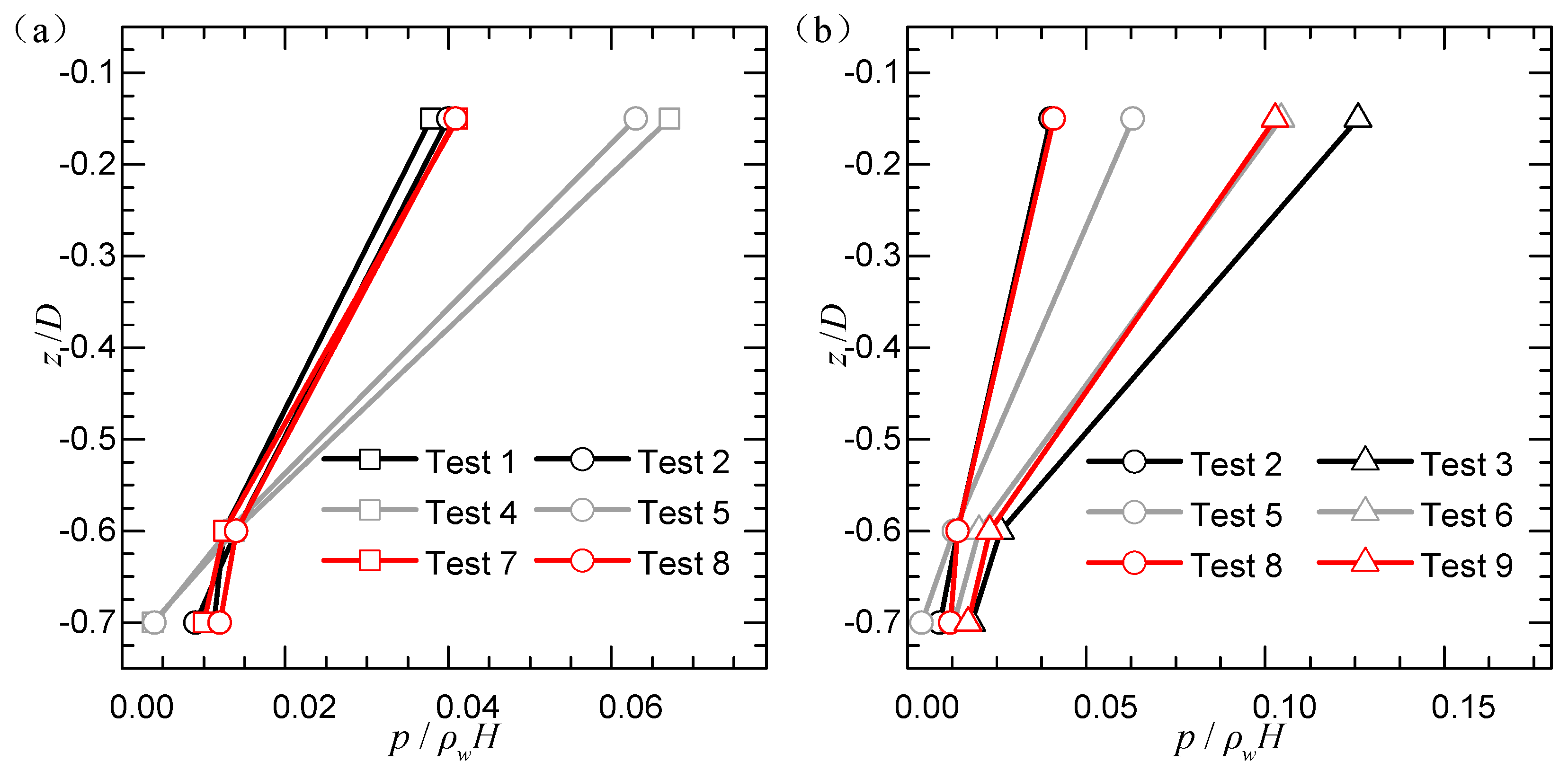
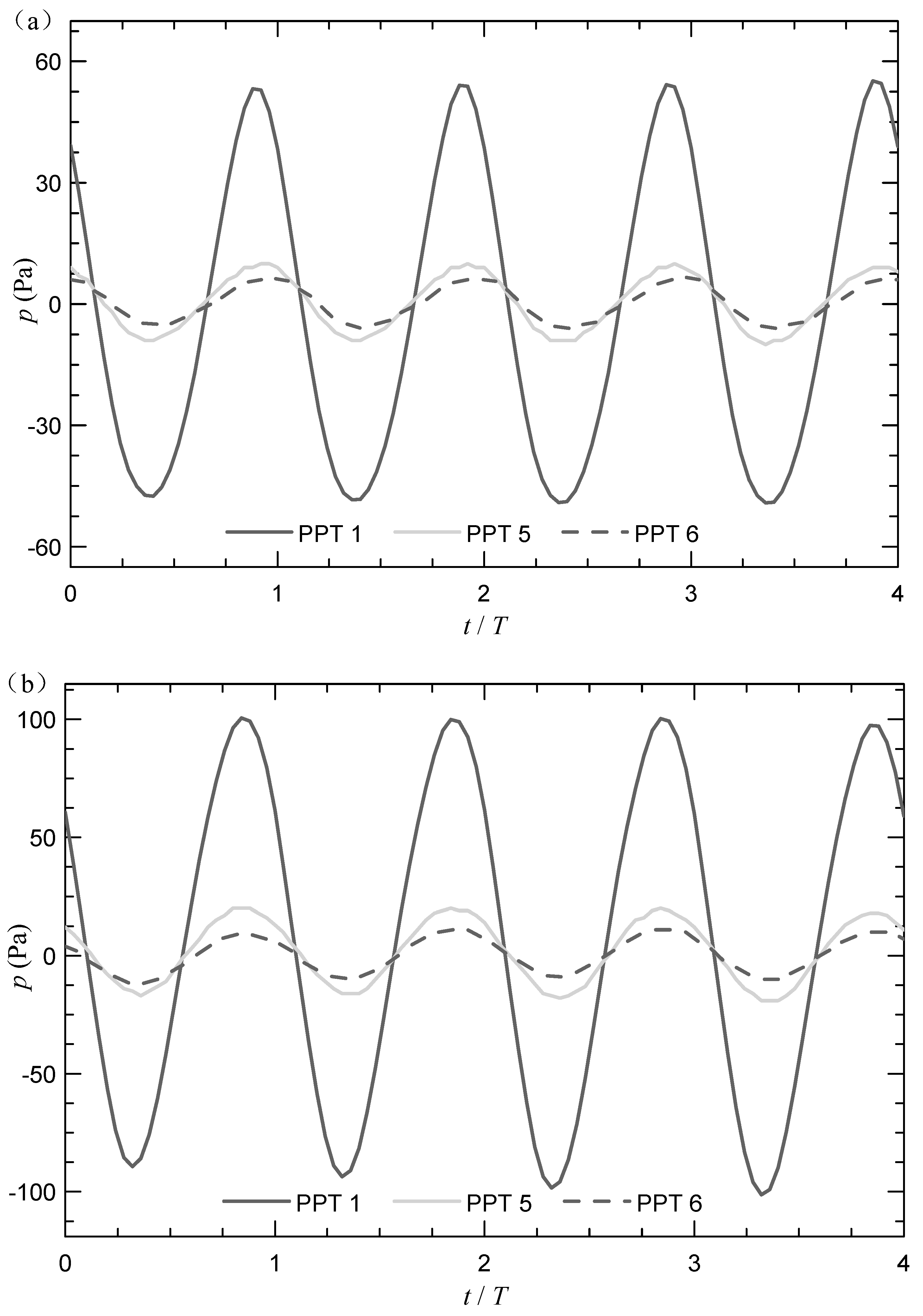
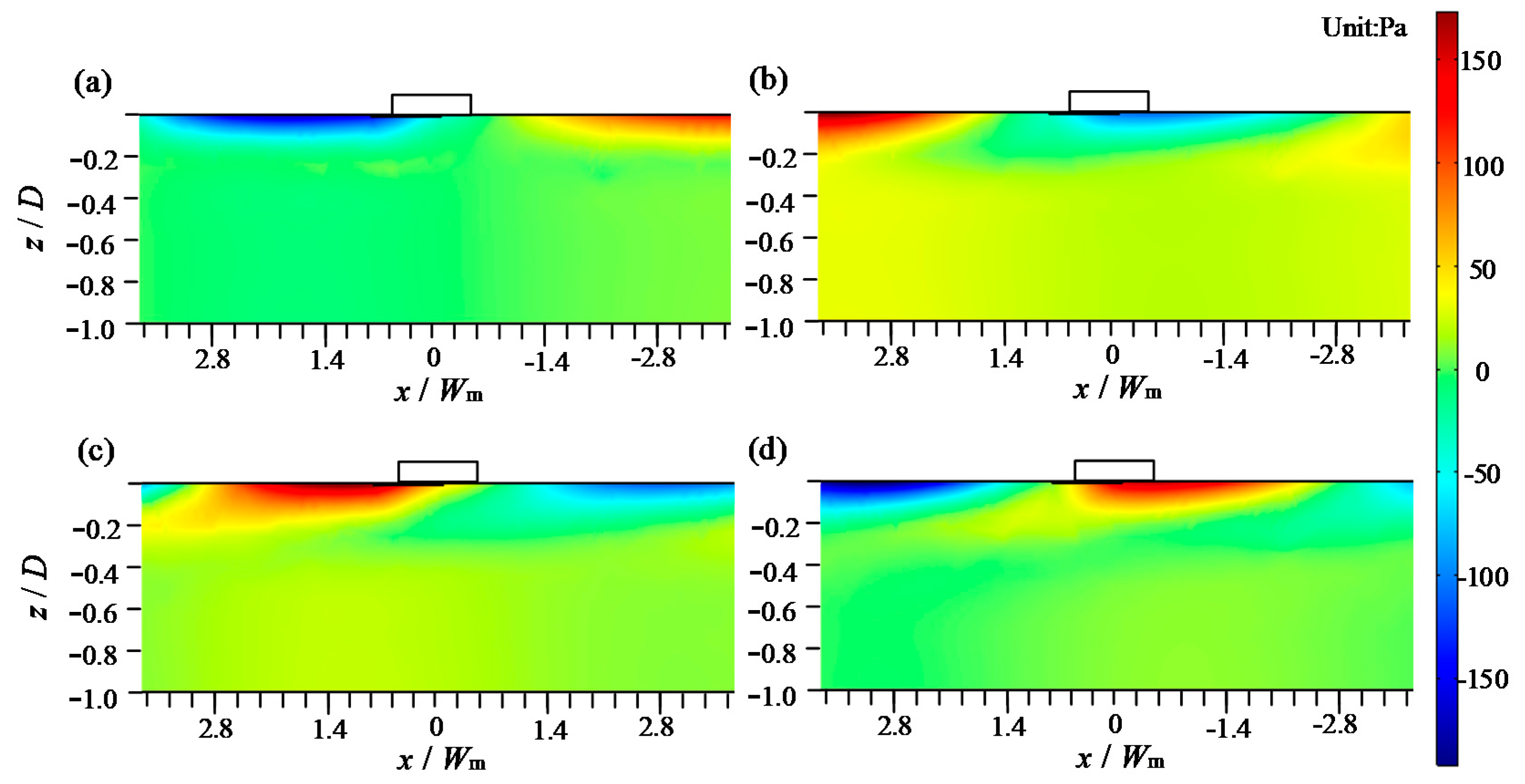
| Soil parameter | Notation | Magnitude | Unit |
|---|---|---|---|
| Permeability | ks | 2.382 × 10−5 | m/s |
| Mean size of sand grains | d50 | 0.215 | mm |
| Soil porosity | ns | 0.448 | - |
| Poisson’s Ratio | ν | 0.333 | - |
| Relative density | Dr | 0.321 | - |
| Unit weight of soil | ρ | 26.79 | kN/m3 |
| Shear Modulus | G | 8.92 × 106 | N/m2 |
| Module | Parameters | Real Value | Proportional Scale | Experimental Value |
|---|---|---|---|---|
| Mat foundation | Length (m) | 35 | 0.7 | |
| Width (m) | 18 | 0.36 | ||
| Height (m) | 4 | 0.16 | ||
| Diameter of pillars (m) | 2 | 0.04 | ||
| Vertical load (N) | 600,0000 | 96 | ||
| Wave | Wave height H (m) | 1.875 | 0.075 | |
| 2.5 | 0.1 | |||
| Wave period T (s) | 7.5 | 1.5 | ||
| 12.5 | 2.5 | |||
| Current | Velocity (m/s) | 1.4 | 0.22 | |
| Water depth | Water depth (m) | 15 | 0.6 |
| Test Number | Water Depth (m) | Wave Height H (cm) | Wave Period T (s) | Wave Length (m) | Mat Foundation | Current (m/s) |
|---|---|---|---|---|---|---|
| 1 | 0.6 | 7.5 | 1.5 | 3.0 | - | 0 |
| 2 | 0.6 | 10 | 1.5 | 3.0 | - | 0 |
| 3 | 0.6 | 10 | 2.5 | 5.7 | - | 0 |
| 4 | 0.6 | 7.5 | 1.5 | 3.0 | Position A | 0 |
| 5 | 0.6 | 10 | 1.5 | 3.0 | Position A | 0 |
| 6 | 0.6 | 10 | 2.5 | 5.7 | Position A | 0 |
| 7 | 0.6 | 7.5 | 1.5 | 3.0 | Position B | 0 |
| 8 | 0.6 | 10 | 1.5 | 3.0 | Position B | 0 |
| 9 | 0.6 | 10 | 2.5 | 5.7 | Position B | 0 |
| 10 | 0.6 | 10 | 2.5 | 5.7 | Position B | 0.22 |
© 2019 by the authors. Licensee MDPI, Basel, Switzerland. This article is an open access article distributed under the terms and conditions of the Creative Commons Attribution (CC BY) license (http://creativecommons.org/licenses/by/4.0/).
Share and Cite
Yuan, Q.; Liao, C.; Zhou, X. Experimental Study on the Distribution of Wave-Induced Excess Pore Pressure in a Sandy Seabed around a Mat Foundation. J. Mar. Sci. Eng. 2019, 7, 304. https://doi.org/10.3390/jmse7090304
Yuan Q, Liao C, Zhou X. Experimental Study on the Distribution of Wave-Induced Excess Pore Pressure in a Sandy Seabed around a Mat Foundation. Journal of Marine Science and Engineering. 2019; 7(9):304. https://doi.org/10.3390/jmse7090304
Chicago/Turabian StyleYuan, Qingyun, Chencong Liao, and Xianglian Zhou. 2019. "Experimental Study on the Distribution of Wave-Induced Excess Pore Pressure in a Sandy Seabed around a Mat Foundation" Journal of Marine Science and Engineering 7, no. 9: 304. https://doi.org/10.3390/jmse7090304
APA StyleYuan, Q., Liao, C., & Zhou, X. (2019). Experimental Study on the Distribution of Wave-Induced Excess Pore Pressure in a Sandy Seabed around a Mat Foundation. Journal of Marine Science and Engineering, 7(9), 304. https://doi.org/10.3390/jmse7090304




